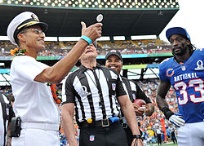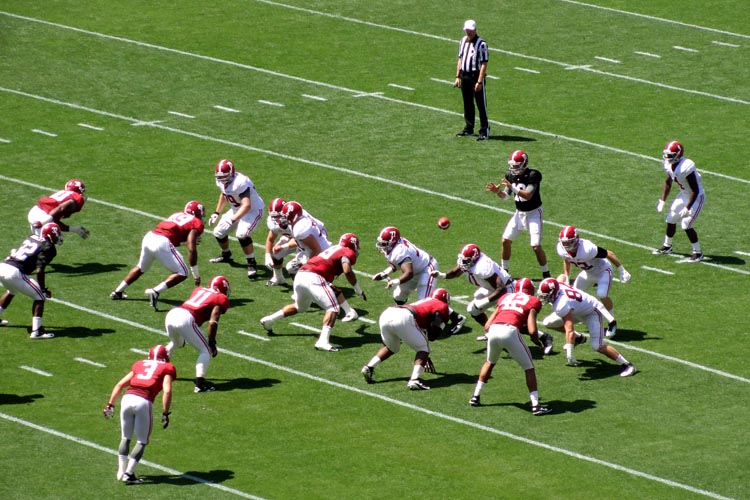The Game Begins!
Now that we have definitions for different terms and events during a football game, let’s see how the game actually progresses!
Before the kickoff, the team captains from each team meet with the head referee at midfield for the coin toss. The visiting team calls heads or tails. Whoever wins the toss has the choice of kicking the ball or receiving the ball to start the game.
 Coin toss at beginning of game
Coin toss at beginning of gameWhen the choice is to kick, it means that team will have the ball to start the second half. You will hear the referee say the team “defers”, meaning they put off receiving the ball until the start of the second half. This is often an advantage for that team.
The ball is placed on a kicking tee on the 35-yard line for the kickoff. The player waiting to receive the ball can choose to run with the ball or call for a fair catch.
If the ball goes into or through the end zone, it is a touchback and comes out to the 20-yard line to start play. If the ball is not caught and goes out of bounds before reaching the end zone, a 5 yard penalty occurs against the kicking team, so the ball is placed at the spot where it goes out of bounds minus 5 yards.
The offense maintains control of the ball until it scores or a fourth down occurs that results in a change of possession to the other team.
 Game play in progress
Game play in progress
This process continues until the end of the first half when a 20-minute timeout is taken and teams leave the field for a break. If a team scores as the clock runs out at the end of the half, one try for an extra point is made before halftime begins.
The second half progresses like the first. If a touchdown is scored as the clock reaches “0” time, one attempt at an extra point may be made if it could mean the team wins or loses the game. Otherwise, when the game clock runs down to 0, the game is over and the team with the most points wins. If the score is tied at the end of “regulation” time, an overtime (OT) period begins.
Rules governing overtime play change often from year to year so I will not get into too many specifics here. The team captains meet at midfield with the head referee and another coin toss occurs.
The team who wins this coin toss chooses whether they want to start on offense or defense. The other team’s captain(s) get to choose which end of the field they want to play from.
The ball is placed on the 25-yard line. Each team has one possession in which to score. The team on offense tries to score first. If they fail to score, the ball goes over to the other team, where they start on the 25-yard line and attempt to score.
If neither team scores, the first OT period is over.
During the second OT period, a 2-point conversion must be attempted after a touchdown.
If there are no media timeouts, there is a mandatory 2-minute break after the 2nd and 4th overtime periods.
Beginning with the third OT period, only 2-point conversions will be attempted.
Routine penalties are not marked off during OT except for flagrant personal fouls, unsportsmanlike conduct fouls, and dead ball personal fouls (see Fouls and Penalties).
This is an over simplified description of the game of football. There are fouls and penalties that are called (see Officiating and Penalties ), and timeouts for various reasons (see Gear Up ). There are several different ways to score points (see Scoring ).
Keep reading to find out all about Scoring!